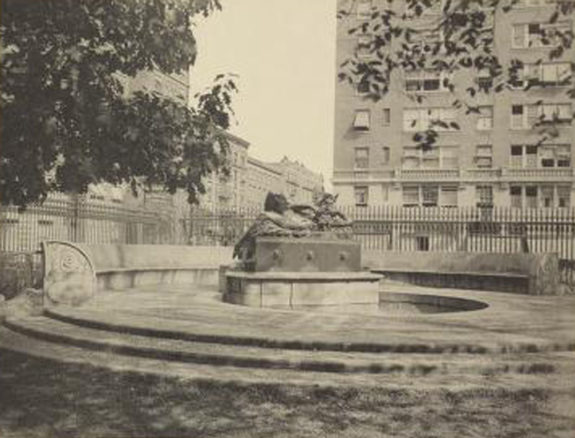Hear the call of the rustic wild—its soft flute tune—right in the middle of New York City.
There are loads of statues around campus. The one I pass by the most is the statue of Pan, located on Lewisohn Lawn. However, like a majority of students, I am not paying attention to the art; I’m speedwalking to my General Chemistry lecture and am not appreciating the bronze masterpiece to my left. Let’s change that now!
Title: The Great God Pan
Artist: George Grey Barnard (1863 to 1938). Sometimes written as George Gray Barnard. (No known connection to the Barnard family.) His more famous works are marble sculptures, one of which is housed in the Metropolitan Museum of Art. Born in Pennsylvania, he studied at the Art Institute of Chicago. Eventually, an art prize enabled him to study in Paris, where he continued his study and spent most of his time working. Rodin—the sculptor of The Thinker—was a major influence in his work. In 1896, he moved back to the United States for seven years. During this time he sculpted The Great God Pan. He returned to France and lived there from 1903 to 1911 where he continued sculpting. Ultimately, Barnard passed away in 1938 from a heart attack.
Figure: Pan. Pan is the ancient Greek god of “nature, the wild, shepherds, flocks, of mountain wilds, and is often associated with sexuality and fertility.” Half man and half goat—in the fashion of satyr but notably not one. A mischievous rustic deity, Pan lives in the wild and plays the flute. Notably worshiped in Arcadia, a wooded Greek region in the center of the Peloponnese (that peninsula shaped like a hand in Southern Greece). During the late 19th century, Pan became more widely used as a symbol of the natural world and playfulness.
In some mythos, Pan tears Echo into pieces after becoming envious of her musical ability. Another story involving Pan is with King Midas—y’know the guy who turns things to gold! After growing to hate wealth, Midas moved to the country and became a follower of Pan. When Pan and Apollo held a musical competition, Midas was the only observer to disagree with Apollo’s victory. Thus, Apollo turned his ears into donkey ears.
The Image: A muscular Pan reclining on a rock and playing his flute.
The Statue: An outdoor sculpture. Bronze Cast—4,300 pounds. About four feet tall, eight feet long, and three and a half feet wide. It rests on a granite base that adds to its height. When cast, it was the largest single-piece bronze cast in the United States.

Where: Outside Lewisohn on the lawn. Enveloped by plants. Originally, it was the centerpiece for an on-campus fountain in the northeast corner of campus (see left). In 1959, it was moved to Amsterdam and 119 (no clue where this would be tbh). In 1963, it was placed in the courtyard between Avery and Fayerweather. Its last location change occurred in 1975 when it was moved to its current location in front of Lewisohn Hall.
When: Barnard designed the statue in 1894 for a luxury apartment building. After Alfred Clark, the original patron, passed, the family donated it to the city of New York to be a fountain centerpiece in Central Park. While the NYC Art Commission approved the gift, the Parks Commission declined it after considering where to place it in the park. The statue was then loaned to the Metropolitan Museum of Art by Edward Clark, son of Alfred Clark. After several more back and forths with the Parks Commission about placement—none of which succeeded—the sculpture was shown in multiple international exhibits. Finally, the statue was donated to Columbia College in 1907.
Why: Nature? Nice thing to have on campus when a wealthy family donates it? The irony for the god of the wilds to be in New York City? Not sure, but I appreciate it!
The Great God Pan via Bwarchives
Pan Fountain, 1918 via Wikimedia Commons


 1 Comments
1 Comments
1 Comment
@Alum It was always in front of Earl Hall.